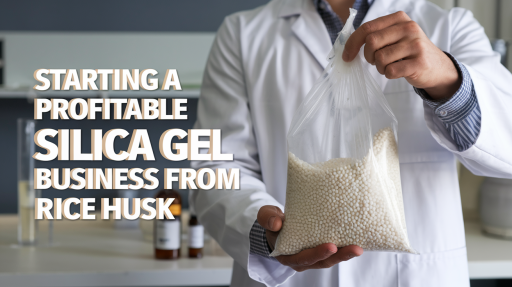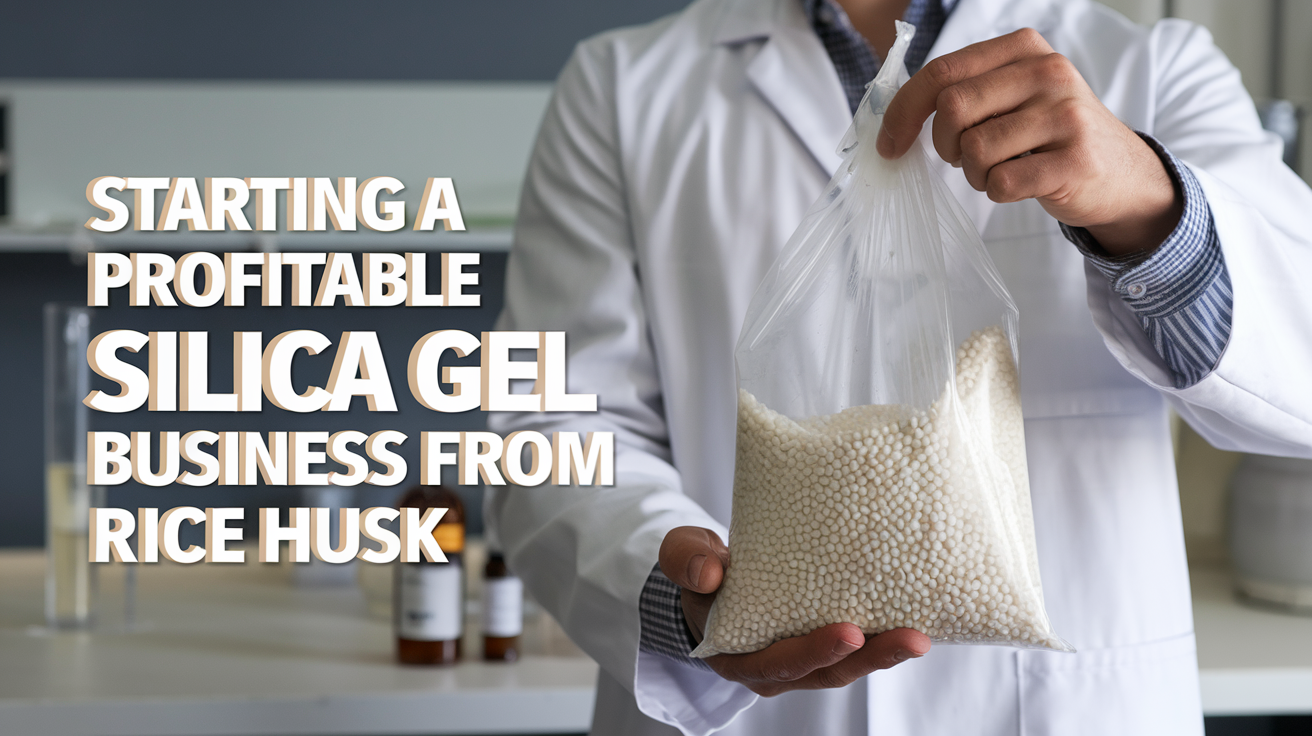Silica gel functions as a widespread desiccant that serves industries that include pharmaceuticals and food packaging together with electronics. The production of silica gel through rice husk materials offers a distinct sustainable method since rice husk arises as a residue during rice processing. Starting a business to make silica gel powder and granules from rice husk stands as a welcoming business opportunity because abundant rice cultivation exists in specific areas. This guide offers specific knowledge about starting an entrepreneur-owned silica gel production business by using real-life data alongside relevant facts and figures.
Visit this Page for More Information: Start a Business in Chemical Industry Projects
Market Overview and Potential
The international rice husk ash industry demonstrates a projected 4.5% compound annual growth rate that will raise market value from USD 2.6 billion in 2023 to USD 3.2 billion by 2028. Rice husk ash has gained increased popularity because its silica substance enables extraction for usage in construction together with agriculture and manufacturing industries.
The escalating industry requests for silica in construction, agriculture and electronics drive the necessitation of sustainable silica production methods. The renewable properties of rice husk provide an environmentally friendly method of silica extraction, which provokes stronger market demand.
Raw Material and Production Process
- Rice husk exists in abundance in rice-producing countries as it presents itself as a low-cost raw material. Rice mills view this material as waste, but it is affordable to obtain because of its availability.
- The first step is to collect rice husks from nearby rice mills before cleaning them through a process that removes dust along with dirt and extrinsic elements. The husks need drying before combustion because reducing their moisture matters for proper ignition.
- The subsequent burning of dried rice husk at 800°C temperature results in the generation of rice husk ash (RHA). Silica appears as raw material through this procedure, whereas RHA normally consists of 60-90% silica. The quantity of silica present in ash directly affects the quality standards of the end product.
- After RHA production, the chemical extraction through sodium hydroxide solution enables silica purification. During the chemical reaction process, the ash dissolves while high-purity silica forms, which proceeds toward silica gel production.
- The extracted silica goes through a process to become silica gel powder products and granules. The product drying process results in granules while powder form production follows for meeting market needs. The final product needs to cover multiple market uses because its two distinct industrial applications require different forms.
Related Project: Manufacturing of Silica Gel Crystal & Beads
Investment and Operational Costs
- Rice husk exists as a byproduct; therefore, its raw material prices remain exceptionally low and sometimes at no cost. The low expense of starting ingredients reaches its minimum value.
- The production requires machinery, including an equipment furnace as well as tanks for chemical treatment alongside units for drying. The expenditure for machinery initialisation depends on operational size yet varied between USD 50,000 to USD 200,000 for small-to-medium scale businesses.
- A qualified workforce needs to control extraction operations and operate the required machinery to maintain labour expenses. Working labour costs in different locations span from USD 3,000 to USD 5,000 each year for each employee.
- Very large quantities of energy are required during both the drying and combustion phases of the process. The wide variation of local energy rates makes this one of the main operational expenses, thus justifying the investment in energy-efficient production equipment.
- Rice husk transportation together with water for chemical solutions and final product packaging costs the business additional operational expenses.
Profitability
- The market value for silica gel powder is USD 2 to USD 5 per kilogram based on purity standards and market conditions. The market demand for rice husk granules results in higher sales prices, which range between USD 4 and USD 8 per kilogram.
- The annual earnings of a small-to-medium-scale plant running at 500 tonnes per year will produce revenue from USD 1 million to USD 4 million depending on market prices and operating scale.
- The low costs of rice husk materials combined with minimal production steps result in noteworthy profit potentials for silica gel manufacturing. Silica gel production generates average profit margins of 30% to 60%, which depend on how well operations run together with market price expectations.
Key Market Applications
Production of concrete utilises silica obtained from rice husk ash as a pozzolanic material for the construction sector. The construction industry finds complete concrete materials with silica gel appealing because it both increases strength and durability while enhancing water resistance.
The agricultural sector utilizes rice husk silica both as a pesticide and for soil improvement. Rice husk silica acts as a beneficial additive which helps plants grow better while making them more resistant to attack by pests. The rising market demand for sustainable farming has led to increasing interest in this particular silica material.
Silica gel serves as a major desiccant substance which protects electronics from water damage by absorbing excess moisture in their packaging. The market continues to expand because of worldwide expansion in the electronics industry.
Related Book: The Complete Technology Book on Chemical Industries
Regulatory Compliance
- The operation needs to follow established environmental standards as part of its mandatory requirements. Operators should conduct rice husk burning within furnaces equipped with emission control systems to reduce pollution generation.
- Proper measures must be implemented to process and dispose the chemical extraction discharge so that soil and water remain free from contamination.
- The extracted silica needs to meet quality specifications which match industry standards. Quality assurance protocols and certification processes support productivity consistency which enables businesses to build strong customer relationships.
Challenges and Solutions
The supply of rice husk encounters interruptions because it mainly comes from local mills which operate during specific seasons. Corporations can reduce this exposure by operating several mills within their supply networks as well as maintaining multiple supplies of silica.
Using rice husk to create RHA requires high energy costs because of the fire-intensive production method. The installation of energy-efficient furnaces together with alternative energy sources such as solar or biomass enables reduction of energy expenses.
Read Similar Articles: Chemical Industry
Conclusion
Starting a silica gel powder and granules business from rice husk presents a lucrative and sustainable opportunity, especially for entrepreneurs in rice-producing regions. The business leverages a low-cost raw material and caters to a growing demand for silica in various industrial applications. With proper investment in technology, a clear understanding of the production process, and a focus on quality, this business can offer significant returns.
For expert guidance, feasibility reports, and tailored business plans, visit Niir Project Consultancy Services to help you set up your silica gel business successfully.







